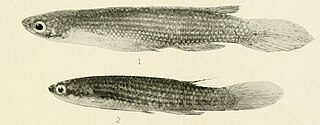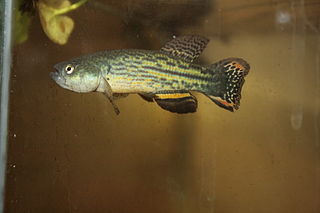
The Rivulidae are a family of killifishes in the order Cyprinodontiformes. They are commonly known as rivulids, South American killifish or New World killifish. The latter names are slightly misleading, however, as they are neither restricted to South America, though most are in fact found there, nor are they the only killifishes from the Americas. Occasionally, they are still referred to as rivulines, a term dating back to when they were considered a subfamily of the Aplocheilidae.

Leptolebias is a ray-finned fish genus of the killifish family Rivulidae. Like many of their relatives, they are rather ambiguously known as "pearlfish".

Austrolebias is a genus of killifish in the family Rivulidae. These annual killifish live in temporary pools, swamps and streams in the Río de la Plata, Patos–Mirim and Mamoré basins in South America.
Pterolebias zonatus is a species of fish in the family Aplocheilidae endemic to the Orinoco River basin in Venezuela where it is found in open waters exposed to sunlight. This species grows to a length of 10 cm (3.9 in). It is found in the aquarium trade. This species is often included in the genus Gnatholebias, of which it has been designated the type species. This species, and Pterlolebias hoignei, are rather distantly related to the other species in Pterolebias and some workers argue that their inclusion in that genus makes it paraphyletic.

Kryptolebias is a genus of killifish in the family Rivulidae mostly native to warm parts of South America but with one species found north through the Caribbean region to the Gulf Coast states of the United States. They are small fish, up to 7.5 cm (3.0 in) in total length. They are non-annual killifish. The genus was originally named Cryptolebias but this name was pre-occupied by a genus of fossil fish.
Maratecoara is a genus of killifish in the family Rivulidae. These annual killifish are endemic to seasonal pools, swamps and lagoons in the upper Araguaia–Tocantins and middle Xingu river basins in Brazil. Most are from savanna regions, but M. gesmonei is from the Amazon rainforest.

Melanorivulus is a genus of South American freshwater fish in the family Rivulidae. Most species are endemic to the Río de la Plata, eastern Amazon, Tocantins–Araguaia and São Francisco basins in Brazil, but a few members of this genus range west into Bolivia, south into Paraguay and Argentina, and east to Parnaíba and Sergipe in northeastern Brazil. Only M. schuncki occurs north of the Amazon River. They inhabit shallow waters, generally 5–30 cm (2–12 in) deep, at the margins of streams in open or fairly open habitats like the Cerrado or Cerrado–Amazon transition. Many have tiny ranges and are seriously threatened.

Anablepsoides is a genus of killifish in the family Rivulidae native to tropical South America and the Lesser Antilles. The majority are from the Amazon and Orinoco basins, as well as freshwater systems in the Guiana Shield, but a few species are from northern Venezuela, northeastern Brazil and the Lesser Antilles. Although largely restricted to lowlands, a few species occur in the lower East Andean foothills. They are mostly found in shallow fresh water swamps, streams, edges of rivers, ponds and pools, but a few may occur in brackish estuaries. They are able to jump over land and breathe air for short periods, allowing them to access isolated waters inhabited by few or no other fish. Several Anablepsoides species have small distributions and some are seriously threatened by habitat loss; the entire known range of A. xinguensis is in the area flooded by the Belo Monte Dam.
Atlantirivulus is a genus of fishes in the family Rivulidae. They are endemic to shallow swamps, creeks, streams and pools in the Atlantic Forest in southeastern Brazil, ranging from Rio de Janeiro to Santa Catarina. Several of the species are highly threatened, while others survive in well-protected reserves. A. janeiroensis was initially feared extinct, but has since been rediscovered in two reserves.
Cynodonichthys is a genus of freshwater killifish in the family Rivulidae. They are found in Middle America, ranging from southern Mexico, through Central America, to Colombia. They are non-annual killifish and inhabit small forest streams from the lowlands to an altitude of 1,500 m (4,900 ft).

Laimosemion is a genus of fish in the family Rivulidae from the Amazon basin and basins in the Guiana Shield in tropical South America. They mostly inhabit small streams, creeks, swamps and pools in lowlands, but locally occur to an altitude of 1,300 m (4,300 ft).

Neofundulus is a genus of fish in the family Rivulidae. These annual killifish are endemic to the Paraguay, Guaporé, Mamoré and São Francisco basins in Argentina, Bolivia, Brazil and Paraguay. They inhabit temporary waters, such as swamps or ponds, that typically are located in open habitats like grassland. Once the water disappears, the adults die, but the eggs that have been laid in the bottom remain, only hatching after several months when the water returns.
Papiliolebias is a genus of fish in the family Rivulidae. These annual killifish are endemic to seasonal pools in the Paraguay and upper Madeira river basins in northwestern Argentina, central and southeastern Bolivia, and western Paraguay.
Pituna is a genus of fish in the family Rivulidae. These annual killifish are endemic to seasonal pools, swamps and lagoons in the Araguaia–Tocantins, Xingu, uppermost Paraná and Paranaíba river basins in Brazil. Most are from savanna regions, but P. xinguensis is from the Amazon rainforest.

Plesiolebias is a genus of fish in the family Rivulidae. These annual killifish are endemic to seasonal pools, swamps and lagoons in the Araguaia–Tocantins, Xingu, and uppermost Paraguay (Pantanal) river basins in Brazil.
Prorivulus auriferus is a genus of fish in the family Rivulidae. It is only known from a small freshwater creek near the coast in the Valença, Bahia region in Brazil. This species is the only known member of its genus. This small killifish is up to about 3 cm (1.2 in) in standard length. Males are overall yellowish, while the smaller females are duller in color.
Stenolebias is a genus of fish in the family Rivulidae. These relatively rare annual killifish are endemic to seasonal waters in the Pantanal in Brazil.
Trigonectes is a genus of fish in the family Rivulidae. These annual killifish are endemic to the Paraguay, upper Madeira and Tocantins basins in far northern Argentina, Bolivia, central Brazil and western Paraguay. They inhabit seasonal swamp, pools and similar habitats in open regions. Once the water disappears, the adults die, but the eggs that have been laid in the bottom remain, only hatching after several months when the water returns.
Yssolebias martae is a species of fish in the family Cyprinodontidae only known from the Río Magdalena near Santa Marta, Colombia. This species is poorly known and may possibly be extinct with only one specimen known. Long of questioned validity and uncertain generic attribution, in 2012 J. H. Huber erected the genus Yssolebias to contain this enigmatic species. This species is the only known member of its genus. This species is placed in the tribe Yssolebiini. It has been suggested that this species is a member of the genus Cubanichthys.
Xenurolebias is a genus of fish in the family Rivulidae. These annual killifish are endemic to temporary pools in the Atlantic forest near the coast in southeast Bahia and Espírito Santo, Brazil.








